Bruising and abrasions are the true companions of any child especially in the summer. Each parent should know how to implement the first medical aid and to alleviate the child's condition by eliminating pain.
Contents
- First aid for bruises and abrasions in children
- First aid for a soft tissue injury for a child
- What kind of help is there for bruises for children?
- How to help with a foot injury to a child?
- First aid for a finger injury in a child
- How to help with a forearm injury to a child?
- How do I get first aid with a hand injury?
- First aid for a bruised abdomen, what should I do?
- How to help with a bruise in the spine?
- What should I do if my head is bruised?
- What should I do if I have a bad bruise?
- What to do first of all with a bruise: advice and feedback
- Video: "A bump on the head of a child! The child fell and hit his head »
First aid for bruises and abrasions in children
- Each parent has the opportunity to face various bruises, abrasions and broken knees in children. This problem is especially frequent in the summer, when the arms and legs of the kids are open and not protected by clothing.care for such bruises is necessary, since untimely treatment can bring the infection into a fresh small wound. This can be the beginning of serious health problems for the child
- No child has yet been able to avoid injuries. In this case, there are light injuries received in any conditions: on the face, while riding a bicycle, roller, sports and even at home. Ranks, bruises, bruises and bruises most often appear in children due to a fall from a small height. Here we have in view of the height of its own growth or stair, chair, curb
- . Scuffs and scratches are most likely to occur due to inaccurate treatment of children with stabbing and cutting objects, glass, wood, metal. The smaller the child by age, the more he suffers from his incorrect coordination of movements. The fact that a small child's head is much larger in relation to the body and most often it causes the inability of the child to keep his balance. The older child suffers from injuries to the
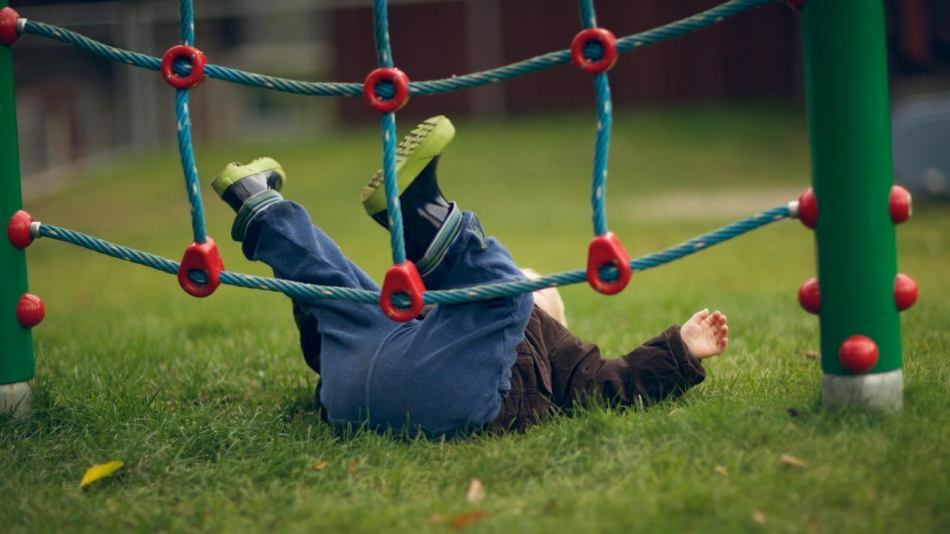 limbs how to help the child with bruises?
limbs how to help the child with bruises? It is possible to distinguish the most common body injuries such as:
- scratches - damage to the top layer of the skin
- abrasions - damage to the skin surface layer more significant than scratch
- cut - simultaneous damage to several layers of skin
First aid for skin damage to the baby:
- Thoroughly rinse the wound from dirt( if any)
- Be sure to stop bleeding( any difficulty)
- Treat the wound with an antiseptic - speciala medical device capable of removing pathogens from the
- wound. Apply a sterile bandage to the wound, protecting it from getting into the wound of germs.
First aid for soft tissue injury for a child
Wash of a wound - is the best and correct first medical aid. Wash the wound with clean water and soap. In this case, it is best to use a cotton swab or napkin, which will help gently moisten and rinse the wound. Thorough washing will save your child from getting the infection in the open wound. Soap has the ability to kill germs, so you should rinse the wound every day until it is completely healed. All the rest of the time the wound should be kept under a sterile bandage.
If you wash the wound not with water, but with hydrogen peroxide, be careful and careful. This method is subject only to minor scratches and abrasions, since the ingress of air bubbles into deeper wounds provokes an embolism - a bubble entering the blood.
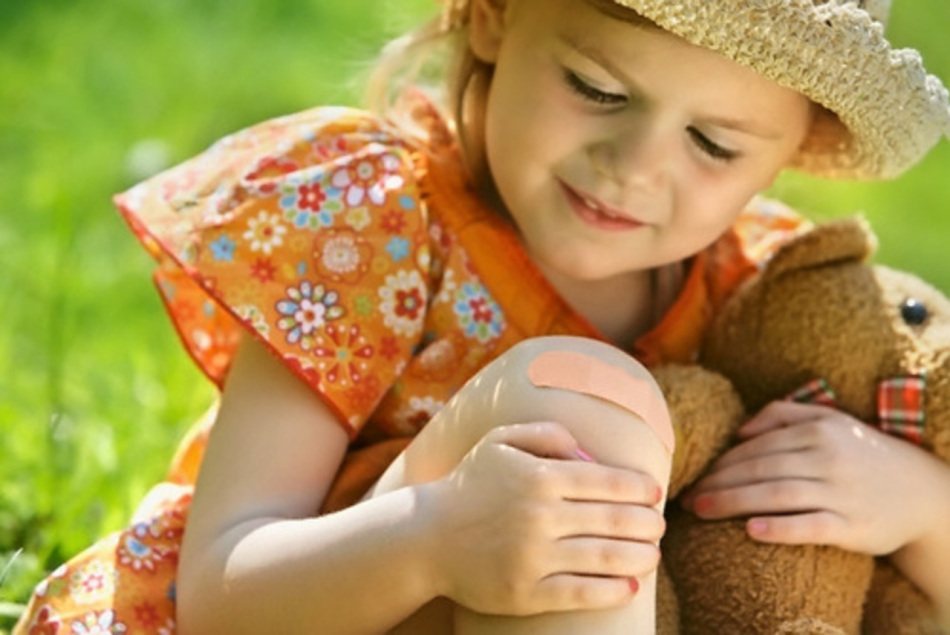 wound washing and first aid to the child
wound washing and first aid to the child If the wound is bleeding, the main task in this case is to stop bleeding. The simplest and most reliable way is to apply pressure. To do this, it is necessary to rinse the wound beforehand, prepare a sterile bandage and apply strong pressure to the wound, leaving this position for fifteen minutes.
If the wound is located on the limbs, it is recommended to lift the damaged limb upward to slow the bleeding. If not severe bleeding, you need to change the bandage, and when strong, apply another one from above - so as not to disrupt the blood clot.
In order to neutralize the site of injury, or to carry out preventive measures to prevent germs from entering the wound, should be treated with an antiseptic. Antiseptics have two advantages:
- to remove inflammation
- to accelerate the healing of
The most common antiseptics that can be used for children are:
- solution of green
- iodine
Important: Be careful! In no case should you use drugs based on ethyl alcohol! Getting into the tissues they can cause necrosis. They are intended only for processing the edges of the wound and the area around the wound.
After rinsing and treating the wound, must be applied with a sterile bandage. She will protect the wound at first and leave it clean. The dressing must be dry.
It is best to use a bandage folded several times or gauze. Remember that the dressing should not be too tight and should have air access that will speed up the healing process. It is best to attach the dressing to the wound with a bactericidal plaster.
If the child has dirty the dressing, replace it. If the dressing has dried to the wound, in no case try to tear it away, soak it with hydrogen peroxide.
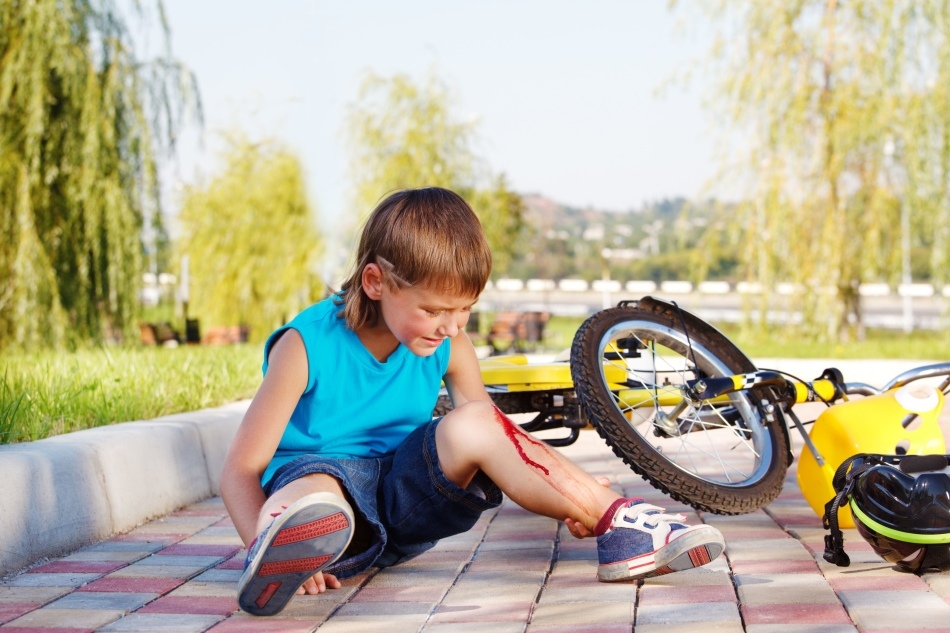 helping a child with a soft tissue injury
helping a child with a soft tissue injury What kind of help is there for bruising for children?
The most common child injury is the bruise. This injury can damage:
- upper layer of skin
- subcutaneous fatty tissue
- muscle tissue
- nerve endings
- blood vessels
When getting a bruise, there is a sharp pain at the injury site because the nerve endings are damaged. And the pain effect varies depending on the place of getting the bruise. Where the accumulation of nerve endings is greater, it is stronger: for example, fingers or face, and where less - not so noticeable: back, buttocks.
If the bruise is strong, then it is quite capable of damaging the blood vessels and as a result, bruise appears in the bruised area. Blood vessels that are located under the skin, pour blood into the surrounding tissues and as a result of which there is a darkening - hematoma .
To make the bruise less or completely get rid of it immediately after a bruise is applied a cold compress. It can be ice wrapped in a towel, or maybe something from the freezer: a piece of meat or a packet of vegetables.
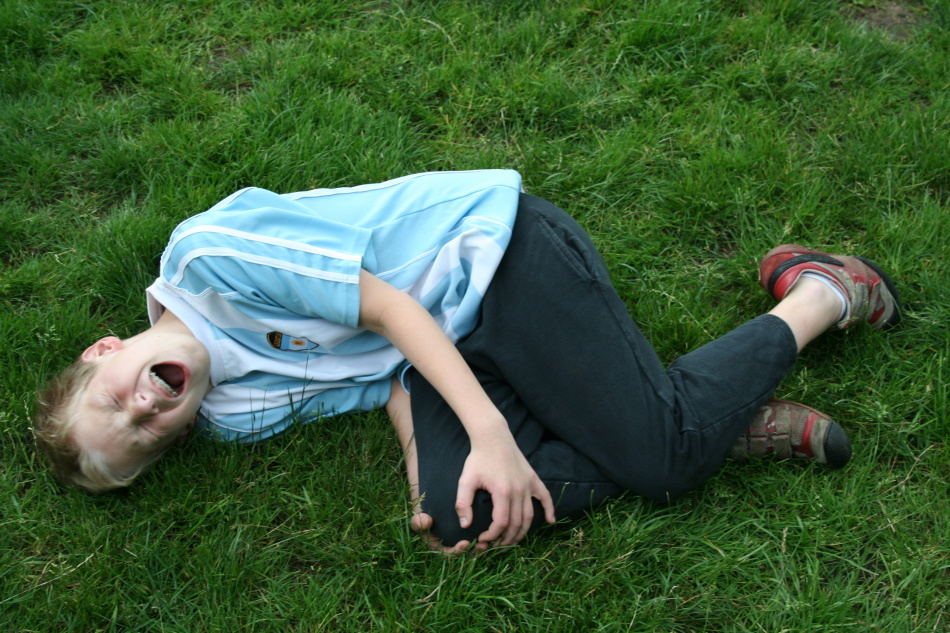 first aid for a child with a bruise
first aid for a child with a bruise A bruise has the property of changing its color:
- bard color - immediately after a bruise, as a result of blood vessel damage
- blue or slightly violet color after folding of blood
- yellow - with a measure of wound healing
Cold compress should be kepton the bruised place for about twenty minutes, then apply a sterile, cold-watered bandage. If the injury is obtained on those parts of the body where it is easy to get an infection:
- jaw
- ears
- nose
It is necessary to watch how the wound behaves and if there is an abscess. This will be said pain sensations, which every day become no less, but stronger. The skin surrounding the hematoma becomes red. Treatment of such cases includes surgical intervention.
In any case, each parent needs to maintain a cool calm and give all his strength to eliminate pain in the child. Excessive panic can develop a child's sense of fear and even increase pain. Remember and explain to the child that any wound heals.
How to help with a foot injury to a child?
Bruising of the foot is very common among children, as every child likes to run, ride a bike and jump. The first medical help in this case includes a number of important measures:
- Ensure complete rest of the injured limb. Sit the child comfortably and calm down. Strong pains last only the first five minutes after the injury.
- Assess the damage. This will help you plan your actions based on the size and nature of the
- wound. Wash the wound, , after all, the child probably got it by hitting the dirty surface: asphalt, earth, stone, curb. Wash the wound with clean water, preferably with soap
- Cool the damaged area. This will help to remove strong pain in the child and weaken the hematoma
- If necessary, use an antiseptic: iodine or zelenka. This is necessary in order to neutralize the wound from getting germs, to remove the inflammation and to accelerate the healing.
- Apply a dry sterile bandage in case of bleeding from the wound. If the wound is not strong, then the bandage can be removed soon
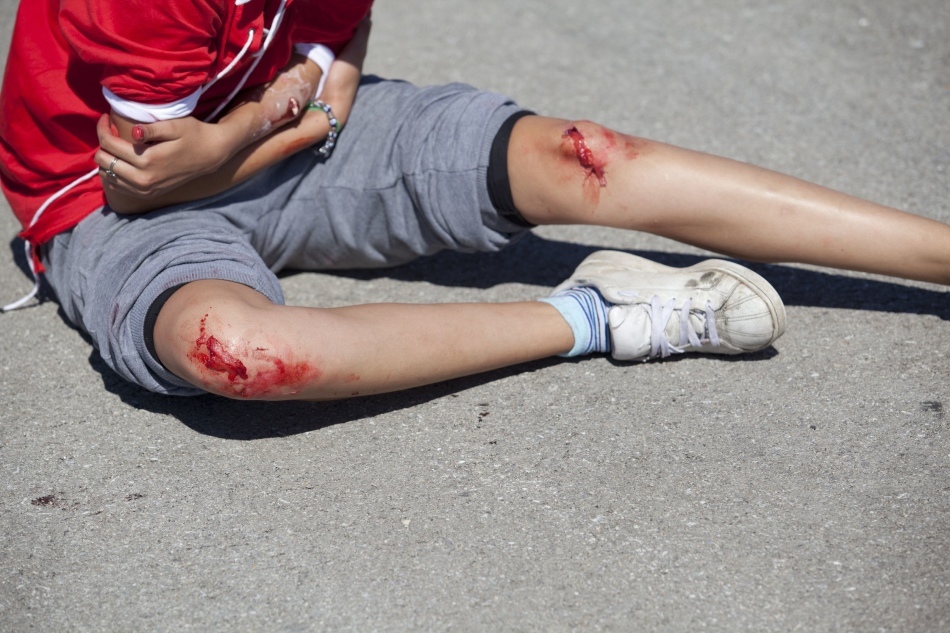 bruises of the lower extremities
bruises of the lower extremities First aid with a finger injury in the child
The bruise on the fingers is painful, as they accumulate a large number of nerve endings. If the finger is bruised, first of all, pay attention to its integrity and exclude a fracture. You can be told about this by severe pain and difficulty in moving your finger. If the fracture is not present, you should conduct the whole range of measures:
- rinse from contamination
- use antiseptic
- apply bandage
- cool the damaged area
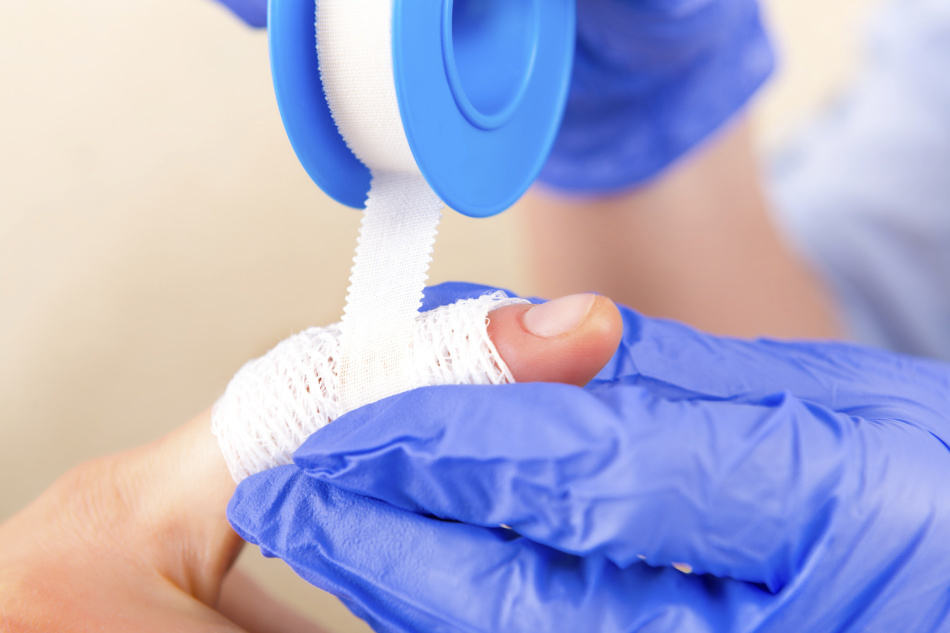 first aid with a finger injury
first aid with a finger injury If you still find a fracture of your finger and visually notice its swelling, an increase in size,blue-blue is a clear indication that you should ensure full immobility to your finger and immediately go to the emergency room.
How to help with a child's forearm injury?
The forearm injury occurs mainly due to a strong impact or a fall. After the child has bruised his forearm and showed you the place where the pain is localized, take a number of important steps:
- provide the child with a comfortable sitting or lying position, grant peace
- assess the site of the injury for the presence of swelling, abrasions and bruises
- check how much the motor function is preservedyour child's hands, this will help to eliminate the fracture
- in case of a fracture, you should immediately go to the emergency department, because you yourself can not solve this problem
- if you found only a bruise, carry out the first medician
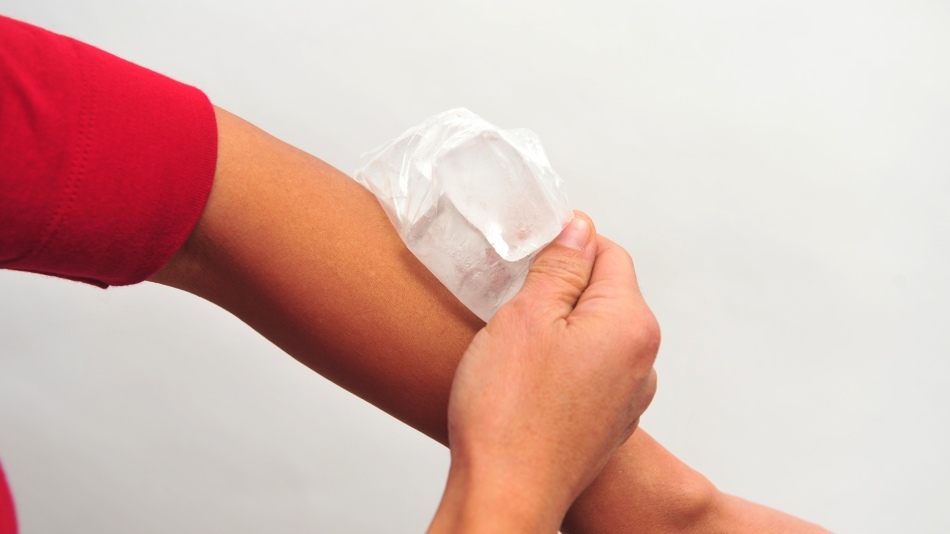 first aid for forearm injury
first aid for forearm injury - if the wound is not deep, wash it with water with soap or hydrogen peroxide( do not rinse the deep wound with peroxide)
- immediately after washing stop bleeding if abrasion is present on the forearm
- to stop bleeding will help pinch the bandage to the wound
- if bleeding wounds are not present, apply cold to the bruised place to weaken the hematoma
How to perform first aid with a bruised hand?
Bruising of the hand in childhood occurs quite often. This is due to the excessive activity of the child and his excessive curiosity. Hands - is that the first thing to explore the world around and become a retarding object in the fall. Depending on the location of the injury, take medical measures:
- wash the wound, focusing on its depth with soap, clean water or hydrogen peroxide
- check how much the motor function of the hand is maintained, this will help to eliminate the fracture
- apply cold to bruises and stop bleeding in abrasions
- apply antiseptic: zebra or iodine if required by wound
- apply a sterile bandage on the wound to keep it clean
- provide hand rest, constantly change the dressings to a cleaner one and fasten them with a plaster
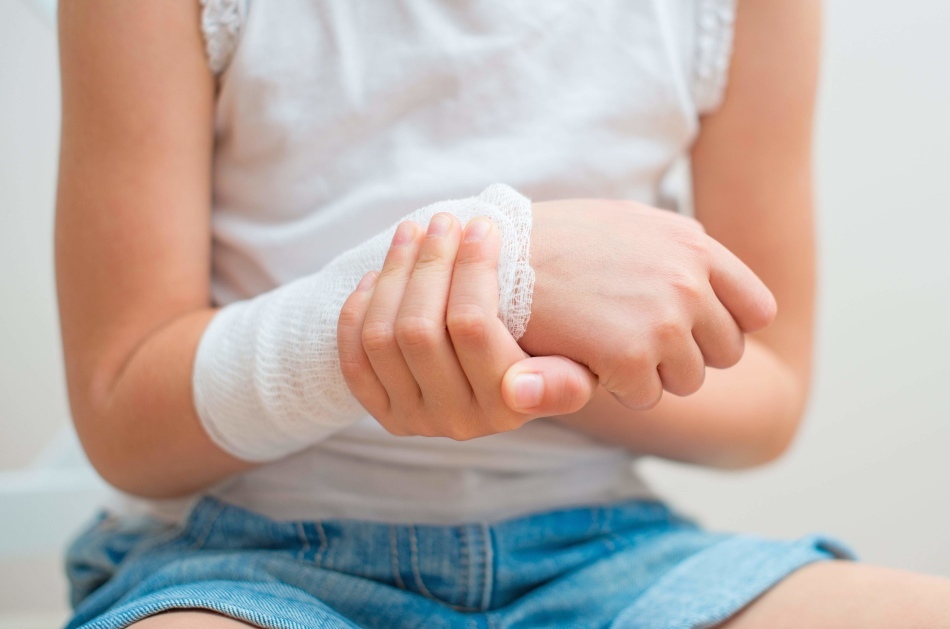 a hand injury in the child
a hand injury in the child First AidWhen abdominal injury, what to do?
It happens that during the fall the child can damage not only the limbs, but also the skin of the abdomen. This happens mostly in the summer, when a child wears a minimum of clothes and often runs, cycling, rollerblading and playing. After the child has received a bruised abdominal injury, you should:
- check the integrity of the skin, treat and disinfect small abrasions and scratches.
- . If the child becomes severely ill, give him complete peace and a horizontal position.
- should ask the child in detail about where he is experiencingpain and call an ambulance if the child strongly complains of pain
- an experienced doctor should assess the condition of the child and exclude internal bleeding
- during a bruised abdomen it is easy to get injureds internal organs, for help in such treatment you need to contact a doctor
How to help with a bruise in the spine?
Injury of the spine is a serious bruise and parents alone can not cope with it. When getting a bruise, parents should call an ambulance and in the meantime provide the child a complete peace and a horizontal position.
The doctor diagnoses the strength of the damage, because the injuries of the spine are different:
- bruise of any vertebrae: one or more
- rupture of connective ligaments that connect the vertebrae
- fracture of the arches
- vertebral displacement
- vertebral fracture
The doctor determines the site of the injury and its location. Injury may be:
- in the lumbar part of
- in the cervical section of the
- thoracic
The complexity of treatment and hospitalization in such cases depends only on how much the spine is injured, whether it is open or closed.
What should I do if my head is bruised?
Head injury is often accompanied in children by cones. Cone - is a hematoma that occurs on the soft tissues of the head due to a severe bruise and a hemorrhage into the skin. The cone is characterized not by strong, but perceptible pains and visual increase.
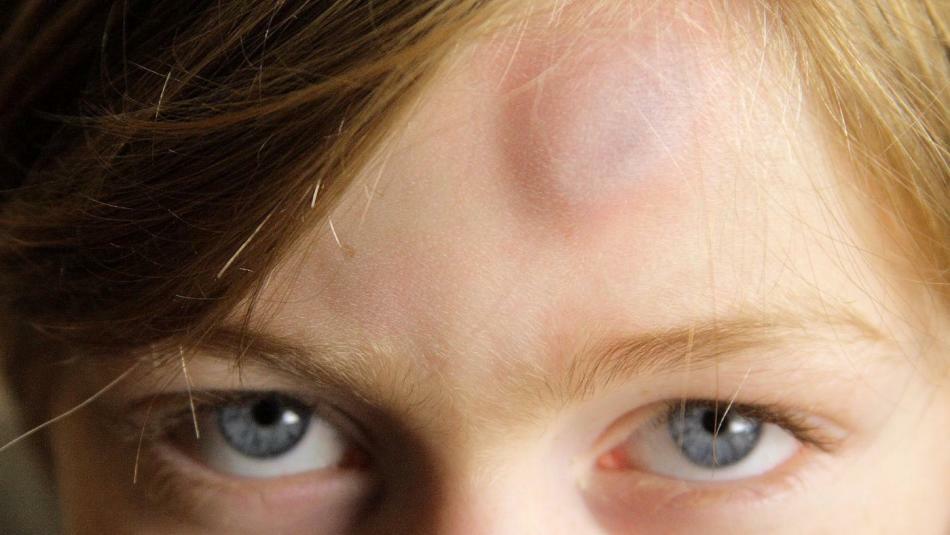 lump on forehead
lump on forehead With stronger bruises, a child may feel a clouding in the head, nausea and even drowsiness. To ease the pain and reduce the bump in size, a cool compress should immediately be applied to it. Be careful, too cold, attached to the head can provoke headaches.
Keep a cold compress on the cone for no longer than fifteen minutes. The child should ensure complete rest and do not disturb him. It is best if the child rests and sleeps. In case the headaches do not disappear and pursue the child and nausea is added to them - it is necessary to consult a doctor in the trauma center for help in order to exclude head trauma.
What should I do if I have a strong bruise?
Strong bruise is always a stress for the child, therefore, when getting a wound, you must properly organize your actions:
- provide the child peace, so that it is not disturbed by surrounding factors
- calm the child and fully reassure him that nothing terrible has happened
- try to provide first aid yourself: disinfect wounds, stop blood, cool bruises, apply bandage
- call a doctor and while you wait for him give the child to drink water, caresses and razgovramie ask him about all the sensations
- remember that your panic and neurosis will only reinforce the fear of the child and strengthen his pain
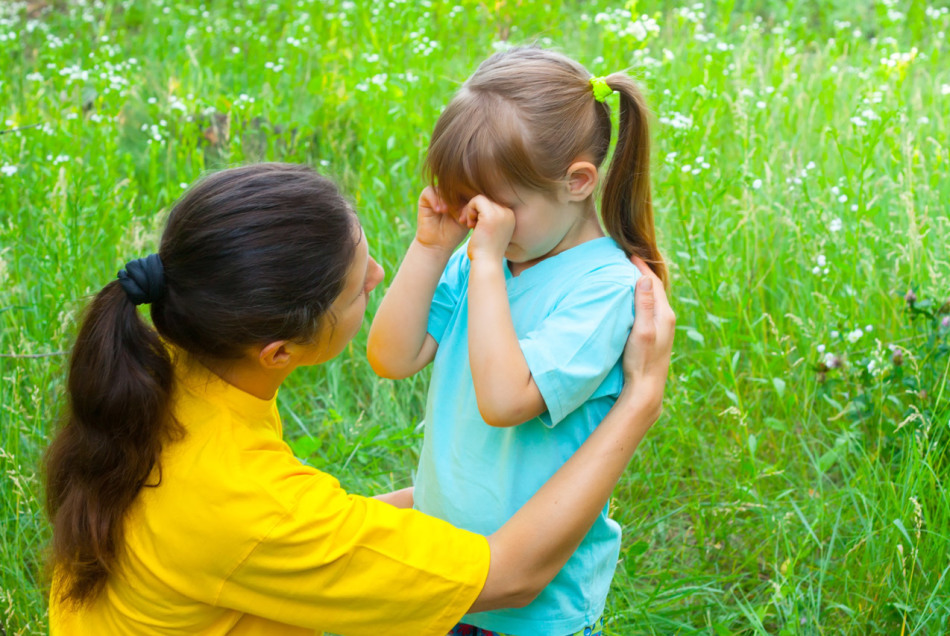 actions of parents in getting injuries by a child
actions of parents in getting injuries by a child What to do first with a bruise: advice and feedback
With an injury every parent should be fully prepared for any difficulties and know about the norms of the first aid:
- have a first aid kit with a full set of medications: iodine, grease, hydrogen peroxide, alcohol, bandages, plaster
- have a wiping technique with soap and clean water
- be able to apply a sterile bandage on the wound, fix it on the body
- be prepared for the child to takeYou will need to transfer it on your hands and provide it with a calm horizontal state
